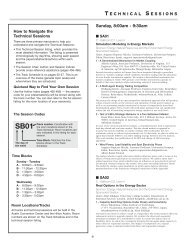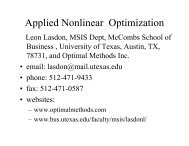[PDF] ALIO Back Matter
[PDF] ALIO Back Matter
[PDF] ALIO Back Matter
You also want an ePaper? Increase the reach of your titles
YUMPU automatically turns print PDFs into web optimized ePapers that Google loves.
SC05<br />
4 - Pressure Distribution in a Complex Gas Pipeline System using<br />
Levenberg-Marquardt Algorithm<br />
Septoratno Siregar, Professor, Institut Teknologi Bandung,<br />
Department of Petroleum Engineering, Jl. Ganesha 10, Bandung,<br />
40132, Indonesia, septoratno@yahoo.com, Edy Soewono, Darmadi,<br />
Lala S Riza, Chasanah K. Widita, Kuntjoro A. Sidarto, Febi Haryadi<br />
Natural gas pipeline network was made up of several points of supply and delivery<br />
connected by pipeline, allowing steady-state flow of natural gas. The system model,<br />
constructed by flow equations in pipeline, consists of a set of nonlinear equations in<br />
pressure obtained by writing the continuity equation at each node in the system. In<br />
this paper, the problem will be formulated as a nonlinear least square problem<br />
which then is solved using Levenberg-Marquardt algorithm.<br />
■ SC05<br />
Velez Sarfield- Second Floor<br />
Revenue Management under Choice Behavior<br />
Cluster: Revenue Management and Pricing<br />
Invited Session<br />
Chair: Gustavo Vulcano, New York University, 44 West Fourth Street,<br />
Suite 8-76, New York, NY, 10012, United States of America,<br />
gvulcano@stern.nyu.edu<br />
1 - Dynamic Pricing and Price Communications Strategies under<br />
Sticker Shock Effects<br />
Garrett van Ryzin, Paul M. Montrone Professor of Business,<br />
Columbia University, 3022 Broadway, 412 Uris Hall, New York, NY,<br />
10027, United States of America, gjv1@columbia.edu, Wei Ke<br />
Popescu and Wu (2006) analyzed a dynamic pricing problem of a monopolist firm<br />
facing product demand that is sensitive to a consumer’s memory and the firm’s<br />
pricing history. We consider an extension on their paper that separates the effect of<br />
price communications from price changes. This relaxes the implicit assumption that<br />
consumers are instantly informed of the retail price changes and provides<br />
interesting insights about when prices changes should and should not be<br />
communicated broadly.<br />
2 - CDLP-based Bid Prices for Network Revenue Management<br />
Juan Chaneton, UBA, Pabellon 1, Ciiudad Universitaria, Buenos<br />
Aires, Argentina, jchaneton@dc.uba.ar, Isabel Méndez-Díaz,<br />
Gustavo Vulcano, Paula Zabala<br />
The primal solution of the linear programming formulation for choice-based<br />
revenue management (CDLP) is known to be effective from a revenue perspective.<br />
However, from a practical perspective, there is a representation issue since airline<br />
systems are in principle incompatible with those offer sets. In this work, we consider<br />
a variation of the CDLP that naturally generates bid-prices. From our exhaustive<br />
numerical experiments, their performance is promising.<br />
3 - A Branch-and-cut Algorithm for the Latent-class Logit<br />
Assortment Problem<br />
Isabel Méndez-Díaz, FCEyN-Universidad de Buenos Aires, Pabellón<br />
1, Ciudad Universitaria, Buenos Aires, Argentina,<br />
imendez@dc.uba.ar, Juan José Miranda-Bront, Gustavo Vulcano,<br />
Paula Zabala<br />
We study the product assortment problem of a retail operation. Each customer<br />
checks the offer set displayed by the firm, and either chooses one of those products<br />
or quits without purchasing. The firm’s goal is to maximize the expected revenue<br />
extracted from each customer. The general version of the problem is NP-Hard. In<br />
this paper, we analyze unconstrained and constrained versions of it, and propose a<br />
B&C algorithm that is computationally feasible and leads to high-quality solutions.<br />
■ SC06<br />
Aula 352- Third Floor<br />
Cost/Performance Analysis<br />
Contributed Session<br />
Chair: Santiago Najera, Gerente de Productividad y Eficiencia, Pronaca,<br />
Los Naranjos N44-15 y Av.de los Granados, Quito, Pi, Ecuador,<br />
santiagonajera@hotmail.com<br />
1 - Calculation of the Constant of Olson using MatLab<br />
Henry Márquez, Professor, Universidad de Oriente, Avda.<br />
Universidad. Dpto. Matemáticas, Cumaná, 6101, Venezuela,<br />
henrylmarquez@gmail.com, Felicia Villarroel<br />
One will settle down a method and its implementation using the computational<br />
package MatLab for the calculation of the exact values of the constant of Olson for a<br />
abelian group of order n, greater or equal to 2.<br />
<strong>ALIO</strong> / INFORMS International – 2010<br />
36<br />
2 - The Financial Aspect of the Managing of the<br />
Processes in Maintenance<br />
Slavica Jovetic, Professor/Doctor, Faculty of Economics, Dj.<br />
Pucara Starog 3, Sv. Markovica 11/A/5, Kragujevac, 34000,<br />
Serbia-Montenegro, sjovetic@kg.ac.yu<br />
TQM idea is: each process and characteristic has its nominal value. Deviation of the<br />
process from its nominal value is considered as loss/ non-quality cost. In this paper<br />
TQM idea is applied and developed for maintenance of the process in an<br />
organization, which has defined its processes and manages them. The paper is a<br />
result of authors’ work on projects of implementing statistical, engineering and<br />
managerial methods of process control as well as on the project of reducing all costs.<br />
3 - Technical Efficiency and Marketing Productivity: Case of a Life<br />
Insurance Company<br />
Hanns de la Fuente, Universidad de Talca, Camino a Los Niches<br />
Km.1, Curicó, Chile, hdelafuente@utalca.cl, Marta Pedraja,<br />
José Luis Rojas, Carmen Berné<br />
This paper analyzes the case of a life insurance company, where levels of technical<br />
efficiency and the factors that determine the marketing productivity are unknown.<br />
It applies Stochastic Frontier approach along with Econometric Models. The results<br />
of this study show increasing levels of efficiency in time, and a marketing<br />
productivity determined by several factors depending on the unit under study.<br />
4 - Managing and Measuring Information System Project Critical<br />
Success Factors<br />
Otilija Sedlak, Associate Professor, Faculty of Economics, Segedinski<br />
put 9-11, Subotica, 24000, Serbia-Montenegro, zotisz@tippnet.rs,<br />
Zoran Ciric<br />
Project performance has become a significant issue, especially as poor performance<br />
in high profile information systems projects. The project critical success factors: cost,<br />
quality, time, customer expectations. In this paper will be evaluated an integrative<br />
framework of performance for managing and measuring projects to bring together<br />
numerous and evolving strands.<br />
5 - Optimizing the Swine Industry Through the Optimization of the<br />
Production Pyramid at the Breeding Farms, using Markov’s Chains<br />
Santiago Najera, Gerente de Productividad y Eficiencia, Pronaca, Los<br />
Naranjos N44-15 y Av.de los Granados, Quito, Pi, Ecuador,<br />
santiagonajera@hotmail.com, Jorge Duque<br />
The present work deals with the aspects of helping optimize the swine industry, all<br />
aimed at finding a better performance for the company and a better service to the<br />
customers. Through the optimization of the management at the breeding farms.<br />
■ SC07<br />
Aula 353- Third Floor<br />
Planning and Scheduling of Industrial Processes I<br />
Cluster: Special Invited Sessions<br />
Invited Session<br />
Chair: Gabriela Henning, Professor, Universidad Nacional del Litoral-<br />
CONICET, Güemes 3450, Santa Fe, SF, S3000GLN, Argentina,<br />
ghenning@intec.unl.edu.ar<br />
Co-Chair: Aldo Vecchietti, Professor, INGAR, Avellaneda 3657,<br />
Santa Fe, 3000, Argentina, aldovec@santafe-conicet.gov.ar<br />
1 - Automated Restoration of Disrupted Schedules<br />
Armando Guarnaschelli, INGAR, Avellaneda 3657, Santa Fe,<br />
Argentina, guarnaschelli@santafe-conicet.gov.ar, Omar Chiotti,<br />
Enrique Salomone<br />
Execution of supply processes is challenged by the occurrence of disruptive events<br />
forcing a rescheduling of tasks to reestablish feasibility of operation. We present a<br />
generic MILP based model which is capable of systematically restoring feasibility of<br />
execution by doing minimum impact modifications to the current schedule, within<br />
the slacks in the resources already provided in the plan. This level of rescheduling is<br />
suitable for gearing an automated execution control system.<br />
2 - A Hybrid Knowledge-based/Constraint Programming Framework for<br />
the Reactive Scheduling of Batch Plants<br />
Juan Matías Novas, Doctoral Fellow, INTEC, Guemes 3450, Santa Fe,<br />
SF, 3000, Argentina, mnovas@intec.unl.edu.ar, Gabriela Henning<br />
A support framework to address the repair-based reactive scheduling problem is<br />
proposed. It is based on an explicit domain knowledge representation and a<br />
constraint programming approach. When an unforeseen event occurs, the<br />
framework captures the in-progress agenda status, as well as the event effect on it.<br />
Provided that good quality solutions can be reached in low CPU times, alternative<br />
solution scenarios focusing on stability and regular performance measures can be<br />
posed for each problem.


![[PDF] ALIO Back Matter](https://img.yumpu.com/17932960/16/500x640/pdf-alio-back-matter.jpg)
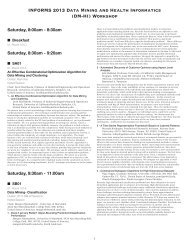
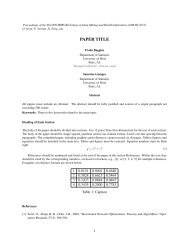
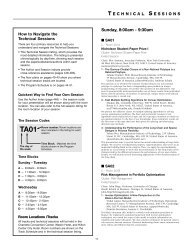
![[PDF] Charlotte Back Matter](https://img.yumpu.com/17933057/1/190x245/pdf-charlotte-back-matter.jpg?quality=85)

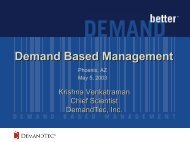
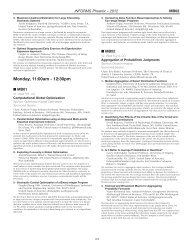
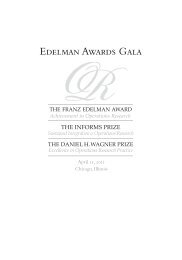
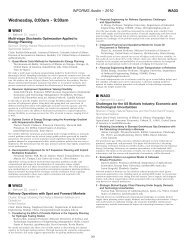
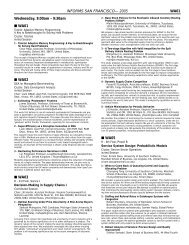
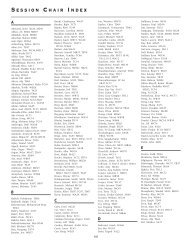
![[PDF] Monday, 8:00am - 9:30am](https://img.yumpu.com/17932954/1/190x245/pdf-monday-800am-930am.jpg?quality=85)
